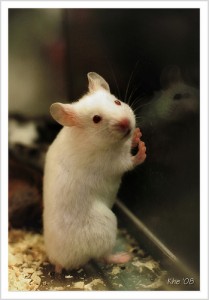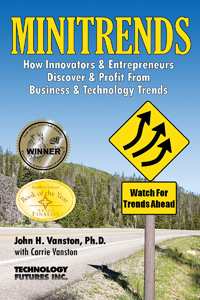Business Trends for Pets and “Petrepreneurs”
March 16, 2011
 We have covered many business trends on this blog that primarily affect humans, but we have been remiss in documenting trends related to our furry and feathered friends: household pets.
We have covered many business trends on this blog that primarily affect humans, but we have been remiss in documenting trends related to our furry and feathered friends: household pets.
Before you pass the iPad to your pooch, I should explain that these trends are very important to people, too. There are many promising opportunities in “petrepreneurship,” and many businesses that serve the needs of pet providers will need good information on where the market is headed.
Let’s start with a few facts courtesy of the American Pet Products Association. How big is the market? The most recent numbers available are for 2009-2010. It’s estimated that in 2010, Americans spent $47.7 million on their pets. An article on 24/7 Wall St combines that information with U.S. Census data to inform us that, “These expenses have increased from 0.9% of household budgets in 1989 to 1.4% in 2009.” That’s more than a 50% increase in the share of household budgets for pets in the last decade. Sounds like a growth industry to me.
In roughly the same time period, the number of U.S. households with pets has increased from 56% to 62%.
And what kind of pets, exactly, are we talking about? Even though more households have a dog than a cat, cats have the upper paw, with 93.6 million feline pets compared with 77.5 million canines. However, there are more pet fish than cats and dogs combined: 171.7 million of them swimming in American aquariums. Rounding out the menagerie are 15 million birds, 13 million horses, and, yesss, over 13 million reptiles.
According to the report, U.S. Pet Market Outlook 2010-2011: Tapping into Post-Recession Pet Parent Spending, Americans are expected to boost their pet spending to as much as $70 billion by 2014. One of the reasons cited is “a human/animal bond that is possibly stronger than ever as a result of the recession.” The report expects spending to increase on “ethical products,” such as “organic/natural, sustainable, humane, etc.”
The breakdown for the $45.5 billion American spent on their pets in 2009 is as follows:
- Food, $17.56 billion
- Supplies/OTC Medicine, $10.41 billion
- Vet Care, $12.04 billion
- Live Animal Purchases, $2.16 billion
- Pet Services: Grooming & Boarding, $3.36 billion
In an amazing article entitled “Pet Trends for 2011,” Laura Bennett, CEO of Embrace Pet Insurance, examines new developments in pet care, noting that “pet parents will cut back on their own expenses before those of their pets.” Here are some highlights:
- Wal-Mart will continue to roll out pet grooming facilities, competing with pet salons.
- “Disney has finally caught on to the trend of vacationers traveling with their pets, opening the Best Friends Pet Care luxury dog and cat resort right across from the Walt Disney World Resort.”
- Pet insurance will continue to surge in growth. “I expect overall premium growth of 14% in 2011 that will see the US pet insurance industry grow to $374 million in GWP [gross written premiums].”
- “Retailers such as Target and Costco are creeping into the domain of the veterinarian… Will 2011 be the year that the pet pharma market is burst open and veterinary hospitals cede billions of dollars in revenue and profit to the retail giants?”
Bennett goes on to cite five marketing trends for pet products that should sound familiar to readers of the Minitrends Blog — or any other blog on technology trends:
- Social Networking, including exclusive networks for “pet parents”
- Local Shopping Sites, including Yelp, which review pet product providers
- Pet Blogs, including Pet Connection, Pawcurious, and YesBiscuit!
According to Bennett, among the most needed services in the pet products industry (are you listening, petrepreneurs?) is the integration of e-commerce websites and social networking. “I have yet to find anyone in the pet space succeeding on this front,” says Bennett. “I have to say that in 2010, there was a paucity of web development in the pet world — a missed opportunity indeed.”
While humans claw their way out of the recession, their pets continue to consume a greater share of disposable income, along with all those treats. And opportunities continue to appear for individuals and organizations who can see the business trends in the booming pet products industry.
STEVE O’KEEFE
News Editor, Minitrends Blog
Source: “Industry Statistics & Trends,” American Pet Products Association, 2009/2010
Source: “Ten Things Americans Waste the Most Money On,” 24/7 Wall St, Feb. 24, 2011
Source: “U.S. Pet Market Outlook 2010-2011: Tapping into Post-Recession Pet Parent Spending,” Market Reports Online, March 2010
Source: “Pet Trends for 2011,” Embrace Pet Insurance
Image courtesy of LASZLO ILYES, used under its Creative Commons license.
A Longer Lifespan with Science and Work
December 10, 2010
 Since I was born, average life expectancy in the U.S. has increased by 10 years, from about 68 years to 78 years. In the next decade, it will increase by another 20 years, according to futurist Ray Kurzweil, who predicts that by the year 2019, the life expectancy of someone born in the U.S. will be over 100 years.
Since I was born, average life expectancy in the U.S. has increased by 10 years, from about 68 years to 78 years. In the next decade, it will increase by another 20 years, according to futurist Ray Kurzweil, who predicts that by the year 2019, the life expectancy of someone born in the U.S. will be over 100 years.
A celebrated M.I.T. scientist, Kurzweil has embarked upon a dietary regimen designed to improve his longevity to the point where “life expectancy is no longer a viable term in relation to intelligent beings.” Until recently, the dominant method of life extension has been calorie restriction. If you can cut your daily calories in half without impacting your vitality, studies show you will live considerably longer.
Last week, another breakthrough offered hope for an engineered end to aging. The forever elusive “fountain of youth” is now pumping out telomerase. Telomerase is an enzyme that keeps telomeres from unravelling. Ewen Calloway, a biotech writer for the journal Nature, which published this new Harvard study, explains the significance of telomeres:
Chromosomes have caps of repetitive DNA called telomeres at their ends. Every time cells divide, their telomeres shorten, which eventually prompts them to stop dividing and die. Telomerase prevents this decline in some kinds of cells, including stem cells, by lengthening telomeres…
In the Harvard study conducted by the Dana-Farber Cancer Institute and Harvard Medical School, mice were genetically engineered with dormant telomerase, resulting in their rapid and premature aging. Feeding the mice a chemical called 4-OHT reactivated telomerase production, and the mice were remarkably restored to a normal age.
There is hope that telomerase could be used to stimulate the growth of neurons, restoring vitality to the worn-out brains and other organs. However, there’s a catch. Tiffany Kaiser at DailyTech delivers the bad news:
While this therapy is ideal for mice, it will be challenging to translate this type of treatment to humans because slowing the aging process this way could increase the risk of cancer in humans. Mice have the ability to create telomerase throughout the span of their lives, but telomerase eventually discontinues in humans in order to stop cells from overpopulating and possibly turning into cancerous cells.
The promise of the Harvard study is that it shows a reverse in aging, not just a halt to aging. The problem is that it did not extend the lives of the mice one bit; it merely returned them to a normal longevity. Kyle Munkittrick at Discover is also skeptical of the translation of this breakthrough to humans:
It still remains to be seen if telomerase treatments can delay normal aging, reverse normal aging, or extend life in any way in mice. From there scientists have to then figure out what side-effects there are, why those side-effects occur, and then somehow translate the results to human beings. [Emphasis his.]
Perhaps telomerase is not the wonder drug that will keep us alive indefinitely. But something is working to expand our life expectancy, and it might be work. In their new book, MINITRENDS, futurist John H. Vanston and his daughter, Carrie Vanston, note with some surprise that the one trait that links successful entrepreneurs is “exceptionally good health.” Which begs the question, which came first, the health or the work?
Jeannine Stein reports for the Los Angeles Times on a study funded by the National Institute on Aging into the effects of employment on the health of retirees:
The researchers coined the term ‘bridge employment’ to describe the transition period between full-time work and full-time retirement, in which people work part time, are self-employed or temporarily employed. Men and women in that bridge employment category reported fewer major diseases and functional limitations compared with those who were in full retirement.
John and Carrie Vanston devote a significant portion of MINITRENDS to exploring the business opportunities for entrepreneurs resulting from life extension. For some employers, it simply means a larger pool of relatively low-cost, experienced workers. Will other countries be insourcing their busy work to our senior citizens?
The Vanstons also see business opportunities in retooling older workers with modern skills. Already, many retirement homes are locating near universities or on college campuses, to give seniors ready access to both the classes and the culture available from the publicly-funded centers of learning.
As many of us face the prospects of living to be 100 years old, it is comforting to know that those later years can be profitably and pleasurably employed providing valuable services to others. Science will continue to improve our ability to work in our later years, and the exciting work of entrepreneurship will continue to keep us young!
STEVE O’KEEFE
News Editor, Minitrends Blog
Source: The Age of Spiritual Machines, by Ray Kurzweil, pp. 208, 280
Source: “Telomerase reverses ageing process,” Nature, 11/28/10
Source: “Harvard Scientists Reverse Signs of Aging in Mice,” DailyTech, 11/29/10
Source: “Another Tiny, Exciting Step Toward Life-Extension,” Discover, 11/29/10
Source: “Considering retirement? Working might keep you healthier,” Los Angeles Times, 11/14/10
Photo by be_khe (Giang Ho Thi Hoàng), used under its Creative Commons license.
Trends in Nanotechnology: Killing Cancer with Light
October 5, 2010

On page 133 of MINITRENDS, Dr. John Vanston describes an interesting experiment in killing cancer cells with light therapy:
A very interesting application of nanotechnology in the medical field is a treatment for cancer currently being developed commercially by BioSpectra. This treatment is based on research developed by Rice University and the M.D. Anderson Cancer Research Institute. When reduced to nano-size, the color of gold depends on the size of the particles, e.g., red, blue or green. In this treatment process, gold particles of a size that corresponds to visible light are attached to biological molecules that migrate to the location of the cancer. The patient is then subjected to a beam of light of the matching color. The energy of the light is deposited in the gold particles, raising the temperature, and burning up the cancerous cells. Visible light can penetrate about 15 centimeters (roughly, six inches) into the body without damaging non-cancerous tissue, contrary to current radiation treatments.
Light therapy has a growing number of uses in the medical field. While the increasing use of light in medicine is a “megatrend,” the particular applications that are coming online in the next few years are Minitrends. These include not only using light to kill unwanted cells, but also to detect them.
Anne Trafton, a biologist and science journalist writing in MIT News, reports on the efforts of MIT researcher Geoffrey von Maltzahn and Harvard-MIT researcher Sangeeta Bhatia to use gold nanorods as a cancer detection tool. Trafton explains how the process works:
Gold nanoparticles can absorb different frequencies of light, depending on their shape. Rod-shaped particles, such as those used by von Maltzahn and Bhatia, absorb light at near-infrared frequency; this light heats the rods but passes harmlessly through human tissue.
The nanorods’ homing abilities also make them a promising tool for diagnosing tumors. After the particles are injected, they can be imaged using a technique known as Raman scattering. Any tissue that lights up, other than the liver or spleen, could harbor an invasive tumor.
Last week, Katia Moskvitch, a Canadian science writer working for the BBC, reported on advances in “Raman spectroscopy,” a method for using light in diagnostics. Raman spectroscopy can rapidly analyze the molecular composition of tissue and bone, detecting abnormalities. Moskovitch interviews University of Michigan researcher, Michael Morris, who says:
Raman gives you a molecular fingerprint, a composition of whatever it is you’re measuring. In diseased states, the chemical composition is either slightly abnormal or very markedly abnormal, depending upon the diseases.
The hope is to conduct diagnostics without needle sticks, blood drawing, or incisions. One of the most sought-after applications is a glucose meter for diabetics, with which the patients would only have to shine a light to their skin, rather than having to prick themselves to draw blood. Shirley S. Wang, a clinical psychologist from Yale University, wrote in The Wall Street Journal that researchers at the G.R. Harrison Spectroscopy Lab at MIT hope to have a wearable diabetes monitor within two to five years.
These are some of the many interesting uses of light in medicine that show promise for development in the near future.
STEVE O’KEEFE
News Editor, Minitrends Blog
Source: “Painless laser device could spot early signs of disease,” BBC News, 09/26/10
Source: “Targeting tumors using tiny gold particles,” MIT News, 05/04/09
Source: “Researchers Beaming at Light’s Medical Uses,” The Wall Street Journal, 08/31/10
Image by alanymchan, used under Creative Commons license.


